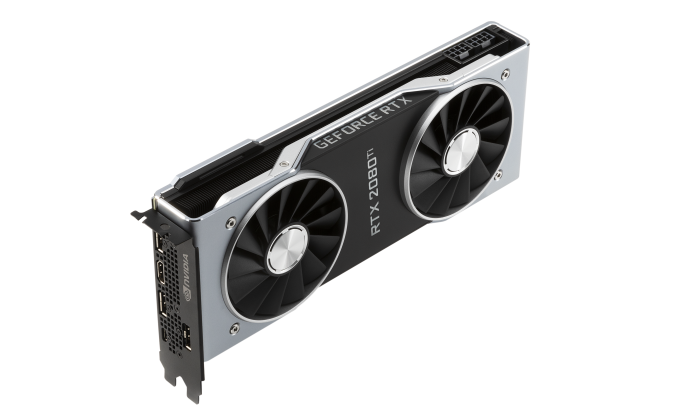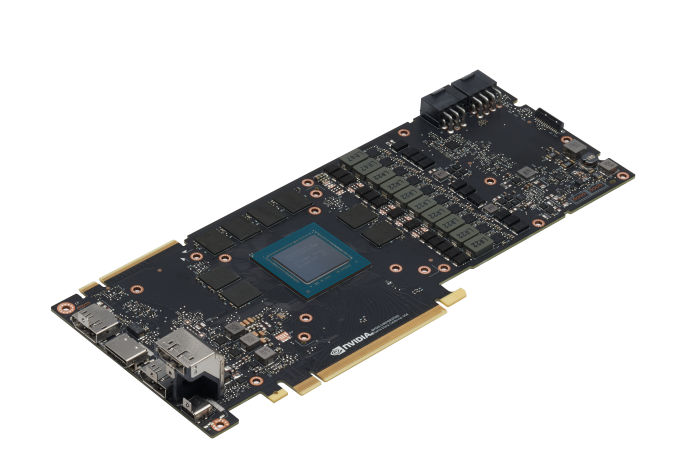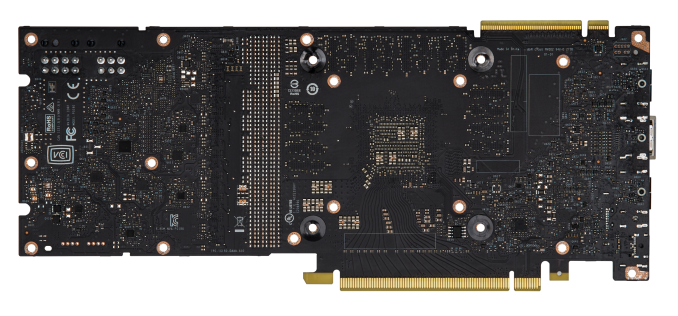The NVIDIA GeForce RTX 2080 Ti & RTX 2080 Founders Edition Review: Foundations For A Ray Traced Future
by Nate Oh on September 19, 2018 5:15 PM EST- Posted in
- GPUs
- Raytrace
- GeForce
- NVIDIA
- DirectX Raytracing
- Turing
- GeForce RTX
Meet The GeForce RTX 2080 Ti & RTX 2080 Founders Editions Cards
Moving onto the design of the cards, we've already mentioned the biggest change: a new open air cooler design. Along with the Founders Edition specification changes, the cards might be considered 'reference' in that they remain a first-party video card sold direct by NVIDIA, but strictly-speaking they are not because they no longer carry reference specifications.
Otherwise, NVIDIA's industrial design language prevails, and the RTX cards bring a sleek flattened aesthetic over the polygonal shroud of the 10 series. The silver shroud now encapsulates an integrated backplate, and in keeping with the presentation, the NVLink SLI connectors have a removable cover.
Internally, the dual 13-blade fans accompany a full-length vapor chamber and component baseplate, connected to a dual-slot aluminum finstack. Looking at improving efficiency and granular power control, the 260W RTX 2080 Ti Founders Edition features a 13-phase iMON DrMOS power subsystem with a dedicated 3-phase system for the 14 Gbps GDDR6, while the 225W RTX 2080 Founders Edition weighing in with 8-phases main and 2-phases memory.
As is typical with higher quality designs, NVIDIA is pushing overclocking, and for one that means a dual 8-pin PCIe power configuration for the 2080 Ti; on paper, this puts the maximum draw at 375W, though specifications-wise the TDP of the 2080 Ti Founders Edition against the 1080 Ti Founders Edition is only 10W higher. The RTX 2080 Founders Edition has the more drastic jump, however, with 8+6 pins and a 45W increase over the 1080's lone 8 pin and 180W TDP. Ultimately, it's a steady increase from the power-sipping GTX 980's 165W.
One of the more understated changes comes with the display outputs, which thanks to Turing's new display controller now features DisplayPort 1.4 and DSC support, the latter of which is part of the DP1.4 spec. The eye-catching addition is the VR-centric USB-C VirtualLink port, which also carries an associated 30W not included in the overall TDP.
Something to note is that this change in reference design, combined with the seemingly inherent low-volume nature of the Turing GPUs, cuts into an often overlooked but highly important aspect of GPU sales: big OEMs in the desktop and mobile space. Boutique system integrators will happily incorporate the pricier higher-end parts but from the OEM’s perspective, the GeForce RTX cards are not just priced into a new range beyond existing ones but also bringing higher TDPs and no longer equipped with blower-style coolers in its ‘reference’ implementation.
Given that OEMs often rely on the video card being fully self-exhausting because of a blower, it would certainly preclude a lot of drop-in replacements or upgrades – at least not without further testing. It would be hard to slot into the standard OEM product cycle at the necessary prices, not to mention the added difficulty in marketing. In that respect, there is definitely more to the GeForce RTX 20 series story, and it’s somewhat hard to see OEMs offering GeForce RTX cards. Or even the RT Cores themselves existing below the RTX 2070, just on basis of the raw performance needed for real time ray tracing effects at reasonable resolutions and playable framerates. So it will be very interesting to see how the rest of NVIDIA’s product stack unfolds.
















337 Comments
View All Comments
imaheadcase - Wednesday, September 19, 2018 - link
Because bluray players played movies from the start, delivered what they promised from the start even if cost a lot? Duh.PopinFRESH007 - Thursday, September 20, 2018 - link
They played DVDs from the start. Your statement is falseimaheadcase - Thursday, September 20, 2018 - link
Umm nope its true.Spunjji - Friday, September 21, 2018 - link
Yeah, there was media available at launch. Also Blu-Ray provided a noticeable jump in both quality AND resolution over DVD. RTX provides maybe the first and definitely not the second.V900 - Wednesday, September 19, 2018 - link
And it’s clear that you didn’t read the article, or skimmed it at best, if you’re claiming that “the two technologies have not even seen the real light of day”.The tools are out there, developers are working with them, and not only are there many games on the way that support them, there are games out now that use RTX.
Let me quote from the review:
“not only was the feat achieved but implemented, and not with proofs-of-concept but with full-fledged AA and AAA games. Today is a milestone from a purely academic view of computer graphics.”
tamalero - Wednesday, September 19, 2018 - link
Development means nothing unless they are released. As plans get cancelled, budgets gets cut and technology is replaced or converted/merged into a different standard.imaheadcase - Wednesday, September 19, 2018 - link
You just proved yourself wrong with own quote. lolGuess what? Python language is out there, lets all develop games from it! All the tools are available! Its so easy! /sarcasm
Ranger1065 - Thursday, September 20, 2018 - link
V900 shillage stench.PopinFRESH007 - Wednesday, September 19, 2018 - link
Just like those HD-DVD adopters, Laser Disc adopters, BetaMax adopters. V900 is pointing out that early adopters accept a level of risk in adopting new technology to enjoy cutting-edge stuff. This is no different that Bluray or DVDs when they came out. People who buy RTX cards have "WORKING TECH" and will have few options to use it just like the 2nd wave of Bluray players. The first Bluray player actually never had a movie released for it and it cost $3800."The first consumer device arrived in stores on April 10, 2003: the Sony BDZ-S77, a $3,800 (US) BD-RE recorder that was made available only in Japan.[20] But there was no standard for prerecorded video, and no movies were released for this player."
Even 3 years after that when they actually had a standard studios would produce movies for the players that were out cost over $1000 and there was a whopping 7 titles that were available. Similar to RTX being the fastest cards available for current technology, those Bluray players also played DVDs (gasp).
imaheadcase - Wednesday, September 19, 2018 - link
Again, the point is bluray WORKED out of the box even if expensive. This doesn't even have any way to even test the other stuff.. You are literally buying something for a FPS boost over previous gens that is not really a big one at that. It be a different tune if lots of games already had the tech in hand by nvidia, had it in games just not enabled...but its not even available to test is silly.